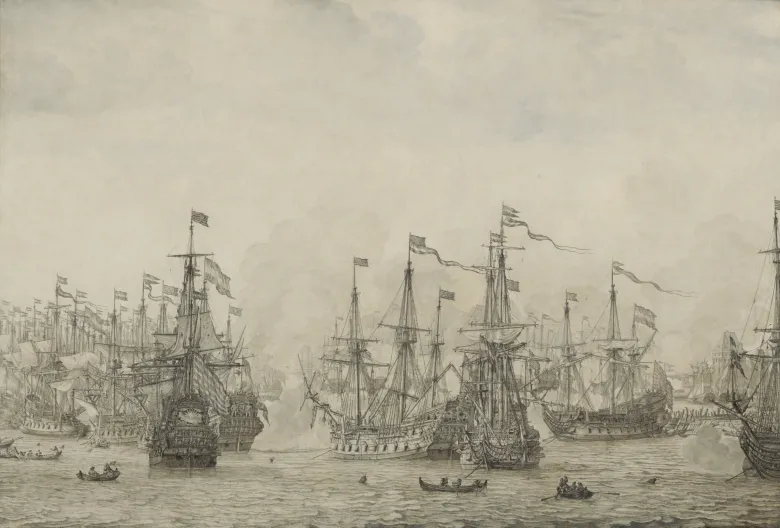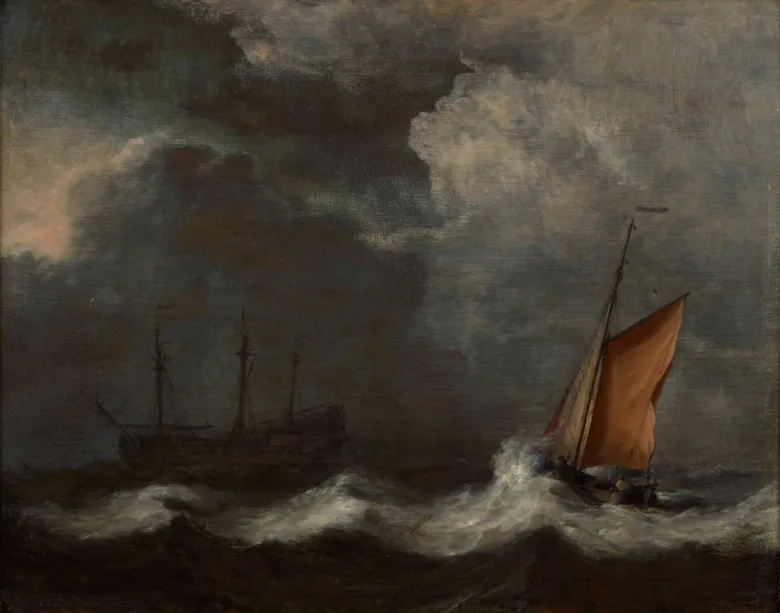Willem van de Velde the Elder and his son Willem van de Velde the Younger are two of the greatest seventeenth-century maritime artists. What is their story?
Willem van de Velde the Elder
Born in Leiden in 1611, Willem van de Velde the Elder was the son of a skipper. It was hardly an auspicious beginning for one of the leading artists of the day: we have no evidence that Willem van de Velde the Elder received any encouragement to become an artist. Perhaps he was inspired by the Van de Veldes’ neighbour on Leiden’s Mandemakerssteeg, painter and engraver Cornelis Liefrinck. On the other hand, the world Willem van de Velde the Elder grew up in prepared him well. As the son of a skipper, he was familiar with the world of ships and shipping, especially on inland waters. He may even have broadened his knowledge as a young adult serving on board as a sailor.
In the 1630s, Van de Velde the Elder set up his own workshop producing maritime art. We find the first evidence of his atelier in Amsterdam, where he settled with wife Judick van Leeuwen and their young son Willem (b. 1633). His earliest products are prints on maritime themes. Yet Willem van de Velde was looking for a new way in which to distinguish his work from that of Amsterdam’s other maritime artists. While competitors painted in oils, producing small seascapes with a broad brush and a gentle palette, Van de Velde pursued a different path. He made brilliant, meticulously detailed, labour-intensive pen paintings in large format on vellum, and later on panel and canvas.

Encounter between Pieter de Bitter’s returning India fleet and an English squadron at Bergen harbour in Norway, Willem van de Velde the Elder, 1666-1668.
Willem van de Velde the Younger
Unlike his father Willem van de Velde the Elder, Willem van de Velde the Younger received a formal education as a painter. He was apprenticed to Simon de Vlieger, a friend of his father’s and a leading marine painter. Willem van de Velde the Younger worked with oil paint and his early paintings show the influence of his teacher. While he also made oil paintings based on his father's pen paintings, he gradually developed his own elegant style portraying the bustling maritime world in the light and space of the coastal waters and the open sea.
A successful studio
The Van de Veldes owed the success of their flourishing workshop to various factors. Van de Velde the Elder was evidently a man of courage, who was present at several naval battles at great personal risk. Using a graphite pen he recorded the encounters he witnessed on scrolls of paper. Later, he presented these documentary drawings to his patrons, enabling them to understand the course of events. Later, these drawings would be developed into pen paintings and oil paintings at his workshop.
The two Willems also owed their success to an excellent network of contacts and patrons who bought their work, among them the influential de'Medici family in Florence.

Painting, Ships in a gale strong wind under a dark sky, Willem van de Velde the Elder, 1672-1707.
Royal commissions
In 1672, a catastrophic year for the Republic of the United Provinces, the art market collapsed. The Van de Veldes decided to move to England where they received a royal welcome at the court of King Charles II. The Van de Veldes were on excellent terms with both Charles II and his successor James II. The Stuarts provided both father and son with an annual pension of 100 pounds and an ample studio at Queen's House in Greenwich. This was also the origin of the commission for the tapestries, two of which were recently acquired by the National Maritime Museum.
After the Dutch stadholder Willem III and his wife Mary Stuart ascended the English throne in the Glorious Revolution of 1688, the Van de Veldes lost their royal patronage and redirected their focus to the free market. Father and son continued to work together until Willem van de Velde the Elder’s death in 1693.
Willem van de Velde & Son was made possible with support from Het Compagnie Fonds, Mondrian Fund, Fonds 21, Turing Foundation, VriendenLoterij, Prince Bernhard Culture Fund, Zabawas Foundation, Nico Nap Foundation, Samenwerkende Maritieme Fondsen and Gravin van Bylandt Stichting.
The Solebay tapestries were acquired with support from Vereniging Rembrandt (and subsidiary Rembrandt UK Circle Fund) and Mondrian Fund, together with the Ministry of ECS Nationaal Aankoopfonds, Vereeniging Nederlandsch Historisch Scheepvaart Museum, VriendenLoterij, Samenwerkende Maritieme Fondsen and Het Compagnie Fonds.